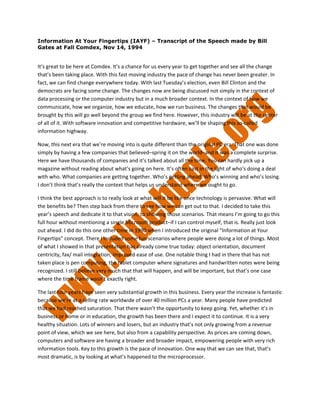
Iayf (provided by bluebugle.org)
- 1. Information At Your Fingertips (IAYF) – Transcript of the Speech made by Bill Gates at Fall Comdex, Nov 14, 1994 It’s great to be here at Comdex. It’s a chance for us every year to get together and see all the change that’s been taking place. With this fast moving industry the pace of change has never been greater. In fact, we can find change everywhere today. With last Tuesday’s election, even Bill Clinton and the democrats are facing some change. The changes now are being discussed not simply in the context of data processing or the computer industry but in a much broader context. In the context of how we communicate, how we organize, how we educate, how we run business. The changes that would be brought by this will go well beyond the group we find here. However, this industry will be at the center of all of it. With software innovation and competitive hardware, we’ll be shaping this so‐called information highway. Now, this next era that we’re moving into is quite different than the original PC era. That one was done simply by having a few companies that believed–spring it on the world–and it was a complete surprise. Here we have thousands of companies and it’s talked about all the time. You can hardly pick up a magazine without reading about what’s going on here. It’s often cast in the light of who’s doing a deal with who. What companies are getting together. Who’s getting ahead. Who’s winning and who’s losing. I don’t think that’s really the context that helps us understand where we ought to go. I think the best approach is to really look at what will it be like once technology is pervasive. What will the benefits be? Then step back from there to see how we can get out to that. I decided to take this year’s speech and dedicate it to that vision, to showing those scenarios. That means I’m going to go this full hour without mentioning a single Microsoft product–if I can control myself, that is. Really just look out ahead. I did do this one other time in 1990 when I introduced the original “Information at Your Fingertips” concept. There I included some fun scenarios where people were doing a lot of things. Most of what I showed in that presentation has already come true today: object orientation, document centricity, fax/ mail integration, improved ease of use. One notable thing I had in there that has not taken place is pen computing, the tablet computer where signatures and handwritten notes were being recognized. I still believe very much that that will happen, and will be important, but that’s one case where the time frame wasn’t exactly right. The last four years have seen very substantial growth in this business. Every year the increase is fantastic because we’re at a selling rate worldwide of over 40 million PCs a year. Many people have predicted that we had reached saturation. That there wasn’t the opportunity to keep going. Yet, whether it’s in business or home or in education, the growth has been there and I expect it to continue. It is a very healthy situation. Lots of winners and losers, but an industry that’s not only growing from a revenue point of view, which we see here, but also from a capability perspective. As prices are coming down, computers and software are having a broader and broader impact, empowering people with very rich information tools. Key to this growth is the pace of innovation. One way that we can see that, that’s most dramatic, is by looking at what’s happened to the microprocessor.
